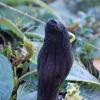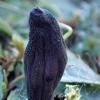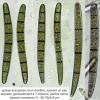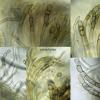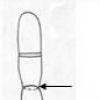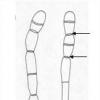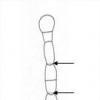
21-12-2025 09:32
Hello.A tiny ascomycete found embedded in wood in

21-12-2025 21:32
Pol DebaenstHello, Garden, Burgweg 19, Veurne, BelgiumOn 10/1

22-12-2025 23:38
Patrice TANCHAUDBonsoir, récolte sur un mur en pierre, apothéci

22-12-2025 00:47
Patrice TANCHAUDBonsoir, récolte à proximité du milieu dunaire

21-12-2025 21:40
Isabelle CharissouBonjour, j'aimerais connaitre les références de

20-12-2025 23:08
Patrice TANCHAUDBonsoir, récolte sur sol sablonneux dans l'arri�
Geoglossum cookeanum ?
Bernard CLESSE,
15-11-2020 08:58
 Non loin de la mer, dans une panne dunaire, en pelouse à épervières piloselles (Hieracium pilosella) sur sable coquillier. Pas de soies.
Non loin de la mer, dans une panne dunaire, en pelouse à épervières piloselles (Hieracium pilosella) sur sable coquillier. Pas de soies.Je pense à Geoglossum cookeanum mais je ne vois pas très clair entre G. cookeanum et G. similie (si cette espèce existe vraiment) ?
Merci d'avance pour vos avis !
Bernard
Charles Aron,
15-11-2020 10:27

Re : Geoglossum cookeanum ?
Hi Bernard,
Some of the spores seem immature but it seems OK for G. cookeianum.
Best wishes,
Charles.
Bernard CLESSE,
15-11-2020 11:36

Re : Geoglossum cookeanum ?
Hi Charles,
Great thanks for your answer !
Best regards,
Bernard
Great thanks for your answer !
Best regards,
Bernard
Charles Aron,
15-11-2020 13:05

Re : Geoglossum cookeanum ?
Hi Bernard,
Regarding G. simile, I'm not familiar with that species but it seems to prefer a swampy habitat, unlike yours. It also has a squamulose stem.
Regards,
Charles.
Bernard CLESSE,
15-11-2020 13:36

Re : Geoglossum cookeanum ?
Ah OK, Charles,
Great thanks for these further information
Best regards,
Bernard
Luc Lenaerts,
16-11-2020 13:42
Re : Geoglossum cookeanum ?
Hello,
Geoglossum simile is a species of peat bogs; grows between sphagnum.
In Geoglossum cookeanum the upper cells of the paraphyses have clear constrictions at all septa, forming pearl necklace chains (moniliform chains), consisting of spherical, egg-, club-, pear-, barrel-shaped to cylindrical cells.
In Geoglossum simile the upper cells of the paraphyses have clear constrictions at the septa usually every two or three septa (see drawings). The paraphyses are only slightly widened; possible presence at the top of 1 (or 2) barrel-looking, septate double cell(s) (see drawings).
Another species, G. uliginosum is closely related to G. simile (one species?). In G. uliginosum many (not all) paraphyses have a pear shaped to spherically widened top cell (see drawings).
Kind regards
Luc Lenaerts
Geoglossum simile is a species of peat bogs; grows between sphagnum.
In Geoglossum cookeanum the upper cells of the paraphyses have clear constrictions at all septa, forming pearl necklace chains (moniliform chains), consisting of spherical, egg-, club-, pear-, barrel-shaped to cylindrical cells.
In Geoglossum simile the upper cells of the paraphyses have clear constrictions at the septa usually every two or three septa (see drawings). The paraphyses are only slightly widened; possible presence at the top of 1 (or 2) barrel-looking, septate double cell(s) (see drawings).
Another species, G. uliginosum is closely related to G. simile (one species?). In G. uliginosum many (not all) paraphyses have a pear shaped to spherically widened top cell (see drawings).
Kind regards
Luc Lenaerts
Bernard CLESSE,
16-11-2020 14:37

Re : Geoglossum cookeanum ?
Thank you very much, Luc ! Very interesting !
Best regards,
Bernard
Best regards,
Bernard
